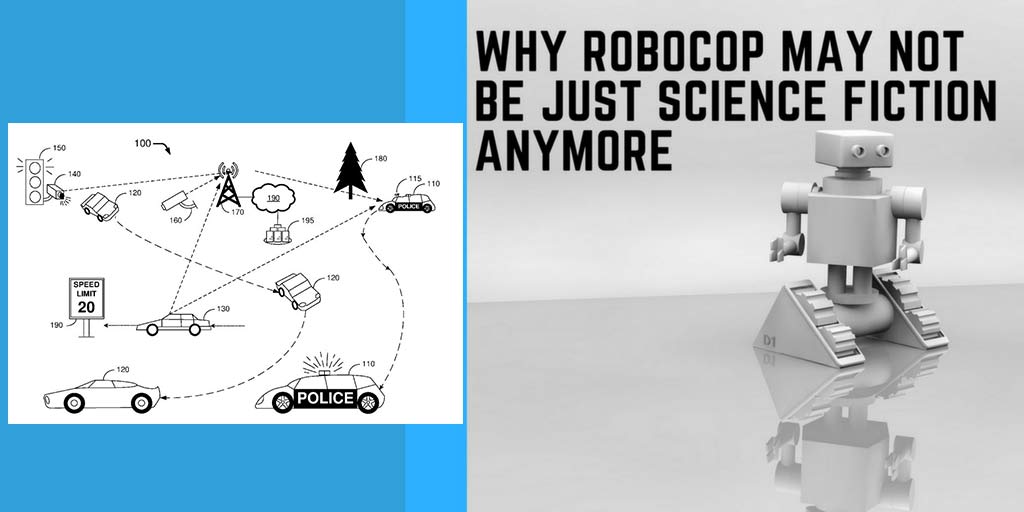Why Robocop may not just be science fiction anymore
We have all seen movies like Robocop, where humans and sentient autonomous robotic beings live side by side in an futuristic society. But that future may be closer than we expect. Ford has recently filed a patent application for an “autonomous police vehicle.” This autonomous police vehicle can be seen as an operational system integrated into a vehicle to carry out law enforcement duties and functions.
For example, Ford’s patent application discloses some of the potential functions that this autonomous police vehicle is capable of:
- enforcing traffic laws by identifying violators,
- pulling over offending vehicles,
- capturing an image of license place of offending vehicles,
- determining the driver of a offending vehicle, receiving an image of the driver’s license (if a human is driving the vehicle),
- authenticating a driver’s license, determining whether to issue a warning or a ticket,
- communicating with a vehicle regarding the warning/ticket decision and an indication that the offending vehicle is free to leave.
Click here to see Ford’s patent application.
How will Ford’s new autonomous police vehicle accomplish these tasks?
There are various ways in which Ford’s new invention can accomplish some of these police related duties. One way the autonomous police vehicle can accomplish a task is to utilizes multiple systems and technologies to perform a function. For example, the invention will potentially have a system to detect speeding vehicles. The autonomous police car initiates this detection system by first using a laser system to detect another vehicle’s speed, and then record that speed into its system. The system then searches local traffic laws and compares the recorded speed to determine whether it is a violation or not. Pretty neat, huh?
The invention can also learn!
The patent application states that the autonomous police vehicle “may be trained or otherwise programmed using machine learning tools (e.g., deep neural networks) to find good hiding spots to catch violators of traffic laws such as, for example, speeders, red light violators and stop sign violators.” Moreover, autonomous police vehicle “may, based on machine learning through deep neural network(s), find a spot behind an object and park at that spot behind object so as to be inconspicuous.” In other words, the autonomous can learn or programmed to find places to hide to catch potential violators.
The autonomous police vehicle works with its surroundings!
Another proposed function of the autonomous police vehicle is that it will be capable of working together with surveillance systems. The autonomous police vehicle can receive indication that a vehicle is violating traffic laws by receiving signals from surrounding technology such as a surveillance camera or roadside sensors. The autonomous police vehicle can then proceed to pursue the other vehicle.
Does the vehicle operate independently of humans?
In some instances, the autonomous police vehicle may not need any human intervention to carry out law enforcement duties. For example, the autonomous police vehicle may be alerted of traffic violations without any help from a human operator. Additionally, the patent application states that the autonomous police vehicle can have an “autonomous driving mode.”
But in other instances, a human operator can also take command of the autonomous police vehicle. The autonomous police vehicle can also have a manual driving mode. Even if we’re not at the stage where technology can enforce laws all by themselves, having technology that helps carries out law enforcement duties will be really helpful for police officers.
But what are the consequences of enacting such as system?
These advances are exciting and all, but it also raises a question: How will society be affected by this new technology? One view would be that it would result in over policing of traffic laws. Some can see this as burdensome. But I take the opposite view. In my perspective, this invention and other related systems will be beneficial to society. Having more enforcement with less costs to society may help facilitate compliance with laws. In other words, if individuals know that they are more likely to get caught violating traffic laws, it may be more likely that these individuals are going to follow the laws to avoid penalties. Having a higher number of people that comply with traffic laws will result in less accidents. That’s a result that benefits everyone.
I mean, who wouldn’t want safer streets where tragic events do not happen often?
What does an invention need to be considered patent eligible?
For an invention to be eligible for patent protection, the invention must satisfy various requirements set out by federal law. These requirements mandate that the invention
- Be deemed as novel
- Not considered obvious
- Be considered patent eligible subject matter
- Have some sort of utility or useful function
To read more about these requirements, click here.
Although Ford’s autonomous police vehicle will probably not be a 15 foot walking robot that can fly, an autonomous police car that can drive by itself and carry out some police duties is still pretty cool.
What are your thoughts on Ford’s patent application? Leave us a comment and tell us what you think!
Want more videos on patents? Here’s a video!
Get Started Today!
Does this article interest you? Subscribe to the LoTempio Law email newsletter to receive posts and updates just like this conveniently in your email box!
If you’ve enjoyed this blog post, we have lots more where this came from, including an Inventors Guide Video Series where we help you turn your good idea into a profitable invention, and tons of other great content. Simply enter your email address and hit sign up and you’ll get everything, including blog posts like these, conveniently in your email box!
Have any questions? Give us a call at 1-800-866-0039. Consultations are FREE.
Disclaimer: This article is not intended to be legal advice and is meant to be for educational or entertainment purposes only. Please do not use the article or contents of the article without permission. For legal advice and questions, please contact registered Patent Attorney Vincent LoTempio.





